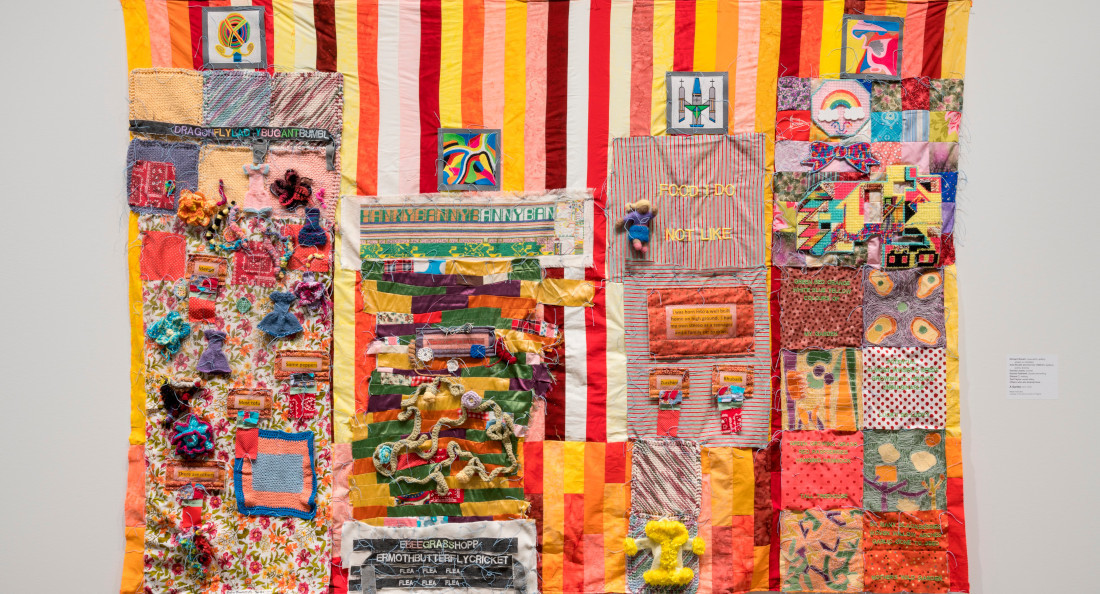Crafting Catharsis
Textile-based exhibition addresses mental health and the purpose of art
If one were to conduct a poll regarding the purpose of art, there would likely be little in the way of consensus. Some may argue that art is meant to serve social causes, while others emphasize personal expression, the pursuit of beauty or simply art for art’s sake.
If I May Digress, a recent exhibition by textile artist Richard Boulet, currently on display at the Architecture 2 Gallery (A2G) at the University of Manitoba, undermines any single answer one might propose to the question of art’s faculty. Boulet’s versatile creations serve as artistic therapy, a powerful advocate for mental health and a well-crafted visual dialect.
The show is curated by Wayne Baerwaldt, who also produced the accompanying catalogue, If I May Digress: Richard Boulet and Collaborators, which launched at the opening event.
Boulet’s exhibition showcases his extensive textile-based practice, encompassing cross-stitching, quilting, appliqué and embroidery.
In an email to The Uniter, Baerwaldt lauds Boulet’s work for its “remarkable combination of fine-craft approaches,” all while maintaining a clear commitment to innovative spatial structure and composition.
Boulet, who was diagnosed with schizophrenia in 1995, views artmaking as a therapeutic practice, describing it as “a quiet and reflective mental-health gift to myself.”
Baerwaldt, expanding on how Boulet’s lived experience has impacted his approach to artmaking, says, “Life experiences with mental challenges have led him to pay close attention to issues of social justice, notions of wellbeing, the omnipresence of poetic inspiration and the psychic and physical space needed to accommodate an emerging queer identity.”
Boulet further expresses autobiographical elements through his use of language, which is woven throughout his pieces as poetic mantras and inner dialogues. These expressions are often cryptic and evocative. Words like “faulty” and “rejoice” are repeated. Other phrases offer opaque declarations, such as “I have more angels than I know what to do with.” and “I love red herrings.”
For Boulet, text and image go hand in hand. “Once the text is created, the rest of the piece is spontaneous,” he says in an email to The Uniter.
“Social facts, concrete poetry and the neurodiverse experience are present in his text work,” Baerwaldt says.
Many of the artworks in If I May Digress incorporate a diverse range of textures and materials, blending figurative and abstract elements into maximalist compositions.
Discussing his artistic influences, Boulet points to medieval illuminated manuscripts as his primary inspiration.
These manuscripts, characterized by their blend of illustration and textual content, were painstakingly created by monks in an era predating the invention of the printing press.
Boulet’s reference to these historical documents offers insights into how one might approach the works which often evoke an ecstatic spirit. For instance, in one piece titled Flag, Boulet writes: “I am the type of man who stitches the feet of queer angels down onto his soul wrap it up wrap it up tight.”
There’s a generosity in Boulet’s approach to art-making. The works in If I May Digress feel introspective yet expressed with an intention of empathy and healing.
“The more I know myself, the better I can understand others,” Boulet says. “Art can be a poem about gratitude and simple pleasures. Art helps me navigate the ups and downs of life.”
If I May Digress runs until Nov. 17 in the Architecture 2 Gallery, Room 215 Architecture 2 Building at the University of Manitoba.
Published in Volume 78, Number 09 of The Uniter (November 9, 2023)







